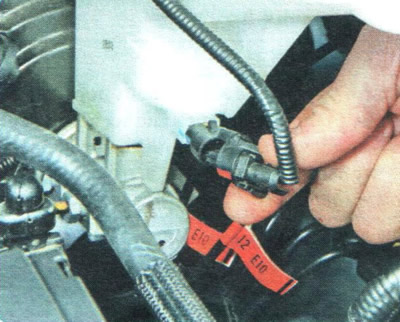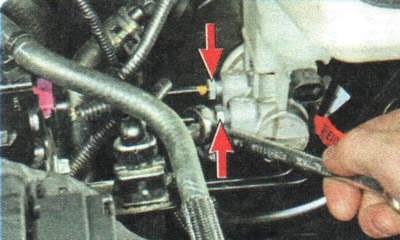
NOTE: Brake line nuts are usually very tight. When you try to unscrew them with an ordinary wrench, the edges of the nuts are crushed, so we recommend using special wrenches for brake pipes.
1. Disconnect the wire from the terminal «minus» battery.

2. Turn away a stopper of a reservoir of the main brake cylinder...

3.... grab the edge of the strainer with pliers...

4....take it out of the tank...

5.... and pump out the brake fluid from the tank, for example, with a large medical syringe. Install a plug to keep dirt out of the master cylinder reservoir.

6. Squeezing the clamps of the wiring harness block of the brake fluid level sensor...

7.... disconnect the block from the sensor.

8. On a car with a manual transmission, disconnect the hose from the reservoir to the clutch master cylinder.
USEFUL ADVICE: Immediately after disconnecting the hose from the tank, plug its hole without lowering the hose down. A little working fluid will remain in the hose, then after installing the reservoir and connecting the hose to it, it will not be necessary to remove air from the clutch release hydraulic drive.
NOTE: On an automatic transmission vehicle, the fitting is plugged.
9. Remove the battery (see «Removing and installing the battery»).

10. Turn away nuts of fastening to the cylinder of two pipelines...

11.... and take the pipelines aside.
GOOD ADVICE: Shut off the pipelines in any way possible (for example, by putting protective caps on the ends of the valves to release air), to prevent leakage of brake fluid.

12. Turn off two nuts of fastening of the main brake cylinder to the vacuum amplifier...

13.... remove the nuts from the bolts of the vacuum brake booster...

14.... then remove the master brake cylinder assembly with the reservoir.

15. If there is no reservoir on the new master brake cylinder or if it becomes necessary to replace the rubber connecting sleeves of the reservoir, remove the reservoir by pressing out the pin of its fastening and removing its branch pipes from the connecting sleeves (see «Replacing the reservoir of the main brake cylinder»).

16. If during operation there was a leakage of brake fluid through the connecting sleeves, remove the sleeves from the openings of the cylinder body.
WARNING: The connecting sleeves must not be reused, replace them with new ones.

17. Remove a rubber sealing ring from the case of the main brake cylinder.

WARNING: Replace the sealing ring of the master cylinder with a new one each time the connection is disassembled.

18. If during operation there was a failure of the brake fluid level sensor, to replace it, press the lock...

19.... and remove the sensor from the tank.
20. Install the brake master cylinder and all removed parts in the reverse order of removal, fill in brake fluid and bleed air from the system. «Bleeding the hydraulic drive of the brake system»).
